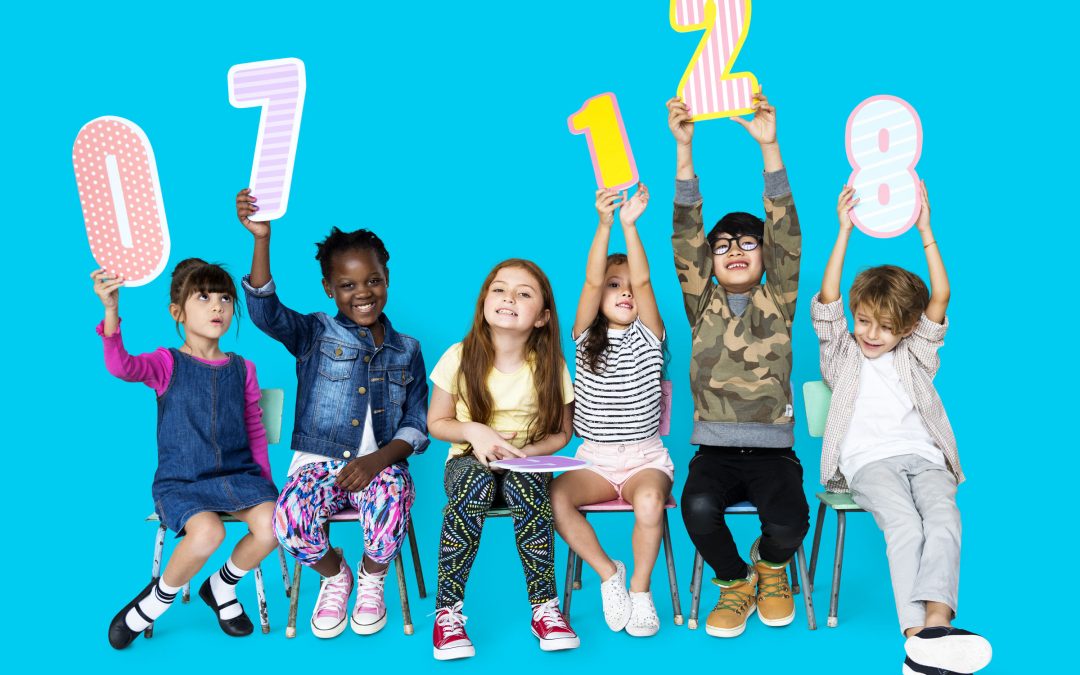In our last post, we discussed learning progressions and their helpfulness in not only understanding children’s development in mathematics, but their usefulness in planning and differentiating instruction. If you didn’t get an opportunity to download the progression on the previous post, you can access it here.
Download Learning Progression Counting Early Numeracy (PDF)
Today, we’re going to explore exactly how children learn to count. The idea of counting seems like such a simple concept, but when broken down, there are actually several distinct counting principles that progressively build toward a child being able to effectively count a group of objects. There are five long-established counting principles that children must know in order to be able to count well. These five counting principles are:
- Stable Order: Understanding the verbal sequence of counting; being able to say the number names in sequential order
- One-to-One Correspondence: Understanding that when saying the names of the numbers in sequence, each object receives one count and one only one count
- Cardinality: Understanding that the last number spoken in a counting sequence names the quantity for that set
- Abstraction: Understanding that it doesn’t not matter what you count, how we count stays the same. For example, any set of objects can be counted as a set, regardless of whether they are the same color, shape, size, etc. This can also include non-physical things such as sounds, imaginary objects, etc.
- Order Irrelevance: Knowledge that the order that items are counted in is irrelevant—left-to-right, right-to-left, in a random fashion—as long as every object in the set is given one count and only one count -Gelman and Galistel, 1978
The first three principles—stable order, one-to-one correspondence, and cardinality—are considered the “HOW” of counting. Research is clear that these are essential for building a strong and effective counting foundation. The remaining two principles—abstraction and order irrelevance—are the “WHAT” of counting. They are not viewed as essential, but it should be noted that efficient counters consistently demonstrate these skills. The short, two-minute video below is a helpful resource for illustrating these five principles.
These five counting principles are part of a clear developmental progression—or learning trajectory—that can be a valuable road map for teachers when used to plan instruction based on each child’s individual needs. It is important to note that the principles of abstraction and order irrelevance are developed simultaneously through one-to-one correspondence and cardinality on the progression. They begin to be understood by children in the Counting phase, but become an essential understanding in the One-to-One phase and the Cardinality phase. Further, order irrelevance is a concept that becomes understood as children work on their one-to-one correspondence, especially when teachers are intentional about questioning and discussing the idea. It is critically important not to assume that these two concepts are intuited by children. Many children have not been fortunate enough to have this idea brought to their attention, and as a result, they have missed out on formalizing these concepts within their learning. As teachers, we must ask questions and discuss these ideas at every opportunity, increasing our intentionality in those teachable moments.
Within the next few weeks on the blog, we will continue to delve into many of the skills listed on the learning progression, particularly those shown to be predictive indicators of kindergarten readiness and later achievement, including subitizing, stable order (verbal counting), object counting with one-to-one correspondence, cardinality, and numeral identification. We will explore what the skill is, why it is important, and how we can provide meaningful experiences for children to build these skills in the classroom. I hope you can join us!
In the meantime, we’d love to hear from you! Let’s learn together! What specific strategies have you used to formalize learning of the five counting concepts for children? In what ways do you use learning progressions to plan instruction and guide the materials you provide in your learning environment?
Note: Special thank you to Side-by-Side consultants Rhonda Birnie and Angie Godfrey for their consultation, guidance, and expertise they provided for this post.
Carrie leads the Side-by-Side team, working in schools and districts, supporting consultants, and ensuring that clients receive the highest quality support possible.


I’m reading Young Children’s Mathematics by Carpenter, Franke, Johnson, Turrou and Wager. After describing this development of children’s counting the authors talk about extending counting to solving problems. I am very interested in their conclusion that children should be asked to solve problems about collections they have already counted AND that it is not always best practice to ask them to imitate a solution strategy that you have modeled. Young children have a lot of fundamental ideas about arithmetic and we want to support them in building upon their own understandings so that they learn to count in the context of solving problems.